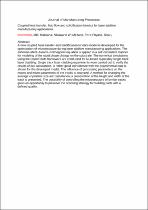 ResearchSpace
ResearchSpace
Coupled heat transfer, fluid flow and solidification kinetics for laser additive manufacturing applications
JavaScript is disabled for your browser. Some features of this site may not work without it.
- ResearchSpace
- →
- Research Publications/Outputs
- →
- Journal Articles
- →
- View Item
| dc.contributor.author |
Khomenko, MD

|
|
| dc.contributor.author |
Makoana, Nkutwane W

|
|
| dc.contributor.author |
Pityana, Sisa L

|
|
| dc.contributor.author |
Mirzade, FKH

|
|
| dc.date.accessioned | 2021-08-04T10:16:12Z | |
| dc.date.available | 2021-08-04T10:16:12Z | |
| dc.date.issued | 2021-07 | |
| dc.identifier.citation | Khomenko, M., Makoana, N.W., Pityana, S.L. & Mirzade, F. 2021. Coupled heat transfer, fluid flow and solidification kinetics for laser additive manufacturing applications. <i>Journal of Manufacturing Processes, 67.</i> http://hdl.handle.net/10204/12068 | en_ZA |
| dc.identifier.issn | 1526-6125 | |
| dc.identifier.issn | 2212-4616 | |
| dc.identifier.uri | https://doi.org/10.1016/j.jmapro.2021.05.019 | |
| dc.identifier.uri | http://hdl.handle.net/10204/12068 | |
| dc.description.abstract | A new coupled heat transfer and solidification kinetics model is developed for the optimization of microstructure during laser additive manufacturing applications. The Johnson–Mehl–Avrami–Kolmogorov equation is applied in a self-consistent manner for modeling of the rapid phase change on the substrate. The numerical simulations using the OpenFOAM framework are conducted for Ni-based superalloy single track laser cladding. Single track laser cladding experiments were carried out to verify the results of our calculations. A rather good coincidence with the experimental data is shown for the developed model. The influence of processing parameters on the macro and micro parameters of the tracks is analyzed. A method for changing the average crystalline size and simultaneous preservation of the height and width of the track is presented. The possibility of controlling the microstructure of similar tracks gives an opportunity to preserve the scanning strategy for building parts with a defined quality. | en_US |
| dc.format | Abstract | en_US |
| dc.language.iso | en | en_US |
| dc.relation.uri | https://www.sciencedirect.com/science/article/pii/S1526612521003418 | en_US |
| dc.source | Journal of Manufacturing Processes, 67 | en_US |
| dc.subject | Convection | en_US |
| dc.subject | Direct numerical simulation | en_US |
| dc.subject | Laser cladding | en_US |
| dc.subject | Microstructures | en_US |
| dc.subject | Solidification kinetics | en_US |
| dc.subject | Model verification | en_US |
| dc.title | Coupled heat transfer, fluid flow and solidification kinetics for laser additive manufacturing applications | en_US |
| dc.type | Article | en_US |
| dc.description.pages | 611-618 | en_US |
| dc.description.note | © 2021 The Society of Manufacturing Engineers. Published by Elsevier Ltd. All rights reserved. Due to copyright restrictions, the attached PDF file only contains the abstract of the full-text item. For access to the full-text item, please consult the publisher's website: https://www.sciencedirect.com/science/article/pii/S1526612521003418 | en_US |
| dc.description.cluster | Manufacturing | en_US |
| dc.description.impactarea | Laser Enabled Manufacturing | en_US |
| dc.identifier.apacitation | Khomenko, M., Makoana, N. W., Pityana, S. L., & Mirzade, F. (2021). Coupled heat transfer, fluid flow and solidification kinetics for laser additive manufacturing applications. <i>Journal of Manufacturing Processes, 67</i>, http://hdl.handle.net/10204/12068 | en_ZA |
| dc.identifier.chicagocitation | Khomenko, MD, Nkutwane W Makoana, Sisa L Pityana, and FKH Mirzade "Coupled heat transfer, fluid flow and solidification kinetics for laser additive manufacturing applications." <i>Journal of Manufacturing Processes, 67</i> (2021) http://hdl.handle.net/10204/12068 | en_ZA |
| dc.identifier.vancouvercitation | Khomenko M, Makoana NW, Pityana SL, Mirzade F. Coupled heat transfer, fluid flow and solidification kinetics for laser additive manufacturing applications. Journal of Manufacturing Processes, 67. 2021; http://hdl.handle.net/10204/12068. | en_ZA |
| dc.identifier.ris | TY - Article AU - Khomenko, MD AU - Makoana, Nkutwane W AU - Pityana, Sisa L AU - Mirzade, FKH AB - A new coupled heat transfer and solidification kinetics model is developed for the optimization of microstructure during laser additive manufacturing applications. The Johnson–Mehl–Avrami–Kolmogorov equation is applied in a self-consistent manner for modeling of the rapid phase change on the substrate. The numerical simulations using the OpenFOAM framework are conducted for Ni-based superalloy single track laser cladding. Single track laser cladding experiments were carried out to verify the results of our calculations. A rather good coincidence with the experimental data is shown for the developed model. The influence of processing parameters on the macro and micro parameters of the tracks is analyzed. A method for changing the average crystalline size and simultaneous preservation of the height and width of the track is presented. The possibility of controlling the microstructure of similar tracks gives an opportunity to preserve the scanning strategy for building parts with a defined quality. DA - 2021-07 DB - ResearchSpace DP - CSIR J1 - Journal of Manufacturing Processes, 67 KW - Convection KW - Direct numerical simulation KW - Laser cladding KW - Microstructures KW - Solidification kinetics KW - Model verification LK - https://researchspace.csir.co.za PY - 2021 SM - 1526-6125 SM - 2212-4616 T1 - Coupled heat transfer, fluid flow and solidification kinetics for laser additive manufacturing applications TI - Coupled heat transfer, fluid flow and solidification kinetics for laser additive manufacturing applications UR - http://hdl.handle.net/10204/12068 ER - | en_ZA |
| dc.identifier.worklist | 24838 | en_US |





